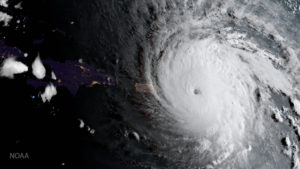
It’s been relatively quiet in the Atlantic basin and the Caribbean since the start of the hurricane season, but Colorado State University hurricane researchers continue to call for an above-average Atlantic hurricane season in 2021, citing the likely absence of El Niño as a primary factor, with a slightly greater than 50-50 chance a storm will make landfall somewhere in the Caribbean.
On Wednesday the CSU meteorologists updated their 2021 hurricane season forecast, reducing by two their prediction for the number of named storms it expects this season – from 20 to 18 – including the five named storms that have already formed: Ana, Bill, Claudette, Danny and Elsa.
Of those, researchers expect eight – including Elsa – to become hurricanes and four to reach major hurricane strength (category 3, 4 or 5 on the Saffir/Simpson scale, with sustained winds of 111 miles per hour or greater.)
In the report, the CSU tropical meteorology team noted that sea surface temperatures across the tropical Atlantic and Caribbean are now warmer than normal. A warmer than normal tropical Atlantic and Caribbean is considered favorable for an active 2021 Atlantic hurricane season, since a warmer than normal tropical Atlantic provides more fuel for developing storms, the report said.
The tropical eastern and central Pacific currently has cool neutral El Niño-Southern Oscillation conditions – that is, the water temperatures are slightly below average. CSU researchers anticipate that these waters are likely to remain cooler than normal for the remainder of the Atlantic hurricane season. Consequently, they believe that El Niño is extremely unlikely this year.
El Niño tends to increase upper-level westerly winds across the Caribbean into the tropical Atlantic, tearing apart hurricanes as they try to form.
Landfall
The report also includes the probability of major hurricanes making landfall after Aug. 4:
– 54 percent chance a major hurricane will make landfall somewhere in the Caribbean (the full-season average for the last century is 42 percent, CSU said);
– 65 percent for the entire U.S. coastline (full-season average for the last century is 52 percent);
– 40 percent for the U.S. East Coast including the Florida peninsula (full-season average for the last century is 31 percent);
– 41 percent for the Gulf Coast from the Florida Panhandle westward to Brownsville, Texas (full-season average for the last century is 30 percent).
As always, the researchers cautioned coastal residents to take proper precautions.
“It takes only one storm near you to make this an active season,” said Michael Bell, professor in the CSU Department of Atmospheric Science.
Forecast models
The team said it bases its forecasts on a statistical model, as well as two models that use a combination of statistical information and forecasts from dynamical models from the U.K. Met Office and the European Centre for Medium-Range Weather Forecasts.
These models are built on 25 to 40 years of historical hurricane seasons and evaluate conditions including: Atlantic sea surface temperatures, sea level pressures, vertical wind shear levels (the change in wind direction and speed with height in the atmosphere), El Niño or warming of waters in the central and eastern tropical Pacific, and other factors.
So far, the 2021 hurricane season is exhibiting characteristics similar to 1996, 2001, 2008, 2011, 2016 and 2017, CSU reported.
“2001, 2008, 2011, and 2016 had near to slightly above-average activity, while 1996 and 2017 were extremely active seasons,” said Phil Klotzbach, a research scientist in the Department of Atmospheric Science and lead author of the report.
The team predicts that 2021 hurricane activity will be about 120 percent of the average season. By comparison, 2020’s hurricane activity was about 145 percent of the average season. The 2020 hurricane season had six landfalling continental U.S. hurricanes, including Category 4 Hurricane Laura, which battered southwestern Louisiana.





